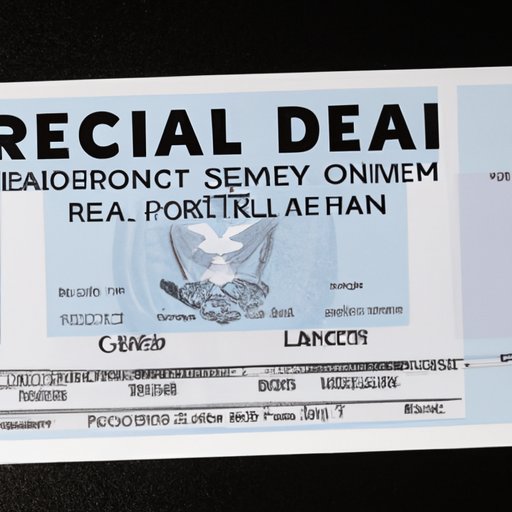
I. Introduction
REAL ID is a federal requirement that has become necessary for citizens of the United States to access certain federal facilities and travel through domestic airports. This article aims to provide an all-inclusive guide to getting a REAL ID, including steps for obtaining it, tips for ensuring your application is successful, and mistakes to avoid.
II. What is REAL ID and Why Do You Need It?
A REAL ID is a government-issued identification that meets federally regulated security and verification standards. It is necessary because it enables individuals to access certain federal facilities, military bases, and domestic flights. Additionally, REAL ID serves as a more secure form of identification, which can be used to prevent identity theft and keep sensitive personal information safe.
III. Step-by-Step Guide to Getting a REAL ID
The process of obtaining a REAL ID involves several steps that should be taken before your current identification expires. To obtain a REAL ID, you will need the following documents:
- One document proving identity, such as a passport or birth certificate
- One document proving Social Security Number, such as a W-2 form or recent tax return
- Two documents proving residency, such as utility bills or a lease agreement
Additionally, you may need to pay a fee for your REAL ID and have your picture taken at the DMV or authorized REAL ID facility. To make an appointment, visit your local DMV website or call to schedule your application appointment. Finally, arrive at your appointment with the necessary documents, and pay any required fees to complete the process.
IV. 10 Things You Need to Know Before Getting a REAL ID
Before applying for a REAL ID, there are a few things to be aware of, including:
- REAL ID is required for access to certain federal facilities, not all facilities.
- REAL ID is required for domestic flights within the United States.
- REAL ID is not required for driving privileges. However, a REAL ID can serve as a driver’s license or state-issued ID.
- You can still access federal facilities and board planes with an alternative form of approved identification.
- Not all states issue REAL IDs. Check with your state’s DMV to verify its availability.
- It is recommended to apply for REAL ID at least six months before your current identification expires.
- To expedite the application process, bring all required documents to your appointment and follow all instructions carefully.
- If your application is not approved for any reason, you may have to start the process again, which can be time-consuming and inconvenient.
- Keep your REAL ID in a safe place and do not share it with anyone.
- Finally, it is crucial to stay aware of any changes to REAL ID regulations, as they may affect your eligibility.
V. How to Prepare for Your REAL ID Appointment
Preparing for your REAL ID appointment can ensure a quick and hassle-free process. Here are some tips for your preparation:
- Read through the state DMV’s REAL ID requirements and checklist thoroughly before your appointment.
- Make a list of all required documents and double-check each item before leaving home.
- Organize your documents in a folder or binder for easy access at the appointment.
- Make a note of any required fees and bring them in the form of a money order, check, or credit/debit card.
VI. Tips for Ensuring Your REAL ID Application is Successful
Submitting an incorrect application can result in mistakes and a delay of approval. Here are some tips for ensuring a successful REAL ID application:
- Read through the instructions carefully and fill out all information accurately.
- Have all required documents on hand before your appointment date.
- Bring a valid form of identification to your appointment.
- Follow all security protocols and guidelines to expedite the process.
- If possible, schedule an appointment during less busy hours to avoid long wait times.
- If your application is not approved, follow up with the DMV or authorized facility to find out why, and correct any errors immediately.
VII. Comparing REAL ID Requirements to Traditional State IDs
While REAL ID and state-issued IDs share some similarities, they also have significant differences in terms of application requirements. For instance:
- REAL ID involves stricter documentation requirements than state-issued IDs.
- The cost of obtaining a REAL ID is generally higher than state-issued IDs.
- REAL ID is required for specific federal facilities and domestic travel; state-issued IDs are not.
- REAL ID is more secure and offers greater protection against identity theft than state-issued IDs.
VIII. Common Mistakes to Avoid When Applying for a REAL ID
Making errors when applying for a REAL ID can result in a delay of approval. To avoid making mistakes:
- Be sure to bring all the necessary documents to the appointment.
- Follow all instructions and procedures closely.
- Do not hesitate to ask for help if you are unsure of what to do.
- If necessary, seek clarification or assistance from the DMV or authorized facility.
- Do not forget to bring the required fees to your appointment.
IX. Conclusion
In conclusion, obtaining REAL ID is an essential requirement to access specific federal facilities and domestic flights within the United States. By familiarizing yourself with the documentation requirements, understanding what to expect during your appointment, and following the tips outlined in this guide, you can make the process of obtaining your REAL ID as smooth and stress-free as possible. Remember, preparation and attention to detail are key to a successful REAL ID application process.





